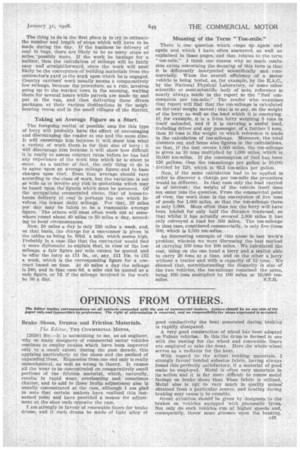OPINIONS FROM OTHERS.
Page 65

Page 66

If you've noticed an error in this article please click here to report it so we can fix it.
The Editor invites correspondence on it subjects connected with the use of commercial motors. Letters shaited be on one side of the per only and typewritten by preference. The right of abbreviation is reserved, and no responsibility for views expressed is accepted.
Brake Shoes, Drums and Friction Materials.
The Editor, THE COMMERCIAL MOTOR, [2659] Sir,—It is astonishing to me, as an engineer, why so many designers of commercial motor vehicles continue to employ brakes which have been improved only to a small extent during the past decade, this applying particularly to the shoes and the method of expanding them. Expansion from one end only is really unmechanical, as well as wrong in theory. It causes all the wear to be concentrated on comparatively small portions of the friction material, which, naturally, results in rapid wear, overheating and sometimes chatter, and to add to these faults adjustment also is usually concentrated at the cam, although I am glad to note that certain makers have realized this lastnamed point and have provided a means for adjustment at the shoe ends oPposile the cam.'
I am strongly in favour of renewable liners for brake drums, and if such, drums be made of light alloy of good conductivity the heatgenerated during braking is rapidly dissipated.
A very good construction of wheel has been adopted on Vulcan vehicles. In this the drum is formed in one with the casting for the wheel and renewable liners are employed to take the wear. Here the whole wheel serves as a radiator for the heat.
With regard to the actual braking materials, I
strongly favour bonded asbestos fabric, having always found this perfectly satisfactory, if a material of good make be employed.' Metal IS often very uncertain in its action and it is far more difficult to renew metal facings on brake shoes than 'When fabric is utilized. Metal also is apt to vary much in quality unless. obtained from a particular source, and heating during braking may cause it to crumble.
Great attention should be given by designers to the brakes on vehicles equipped with pneumatic tyrers Not only do such vehicles run at higher speeds and, consequently, throw more stresses upon the braking,
tint the heat generated is much higher, and, as the tyres are usually so close to the drums, they are apt to be damaged, sometimes to a serious extent.
Enclosing brake shoes to prevent the entry of mud and water is advantageous from this particular point of view, but presents disadvantages in that the condition of the shoes cannot readily be seen and cooling air cannot enter the drums. Whether the advantages outweigh the disadvantages is a moot point.—Yours faithfully, ENGINEER. London, W.
• Organization of Road Transport. The Editor, THE COMMERCIAL MOTOR.
[26601 Sir,—We have read with interest the report on a paper read at the Midland Local Section of the Institute of Transport by Mr. W. Donaldson Wright, on "Organizing the Road Transport of Goods," in the issue of The Commercial Motor for January 170. We have felt foi.' a considerable time that more cooperation is needed in the road transport industry. It was with this object in view that we sent out a circular letter to members of the industry in December last, informing them of the fact that we were opening a goods transport bureau on January .2nd, 1928, for the purpose of obtaining return loads or part loads for carriers running regularly between London and the principal towns in England, etc. Our charges are based on a low percentage. All 'goods are collected by our vans in London and brought to our depot, -where they are collected by the carriers, thereby saving the haulier's time and money, which would have to be expended in collecting from various addresses.
As Mr. Wright points out, undercutting of rates is of no good to the individual. haulier and most harmful to the industry, but, on the other hand, it is essential that rates be reasonably low, so as to be an inducement to send goods by road.
We shall be pleased to dismiss this matter further • with anybody interested, especially with other centres. Our address is 288, King Street, Hammersmith, London, W.6.—Yours faithfully, " C. T. SHAWE AND SON,
Hammersin C. R. TRUBSHAWE.












































































































